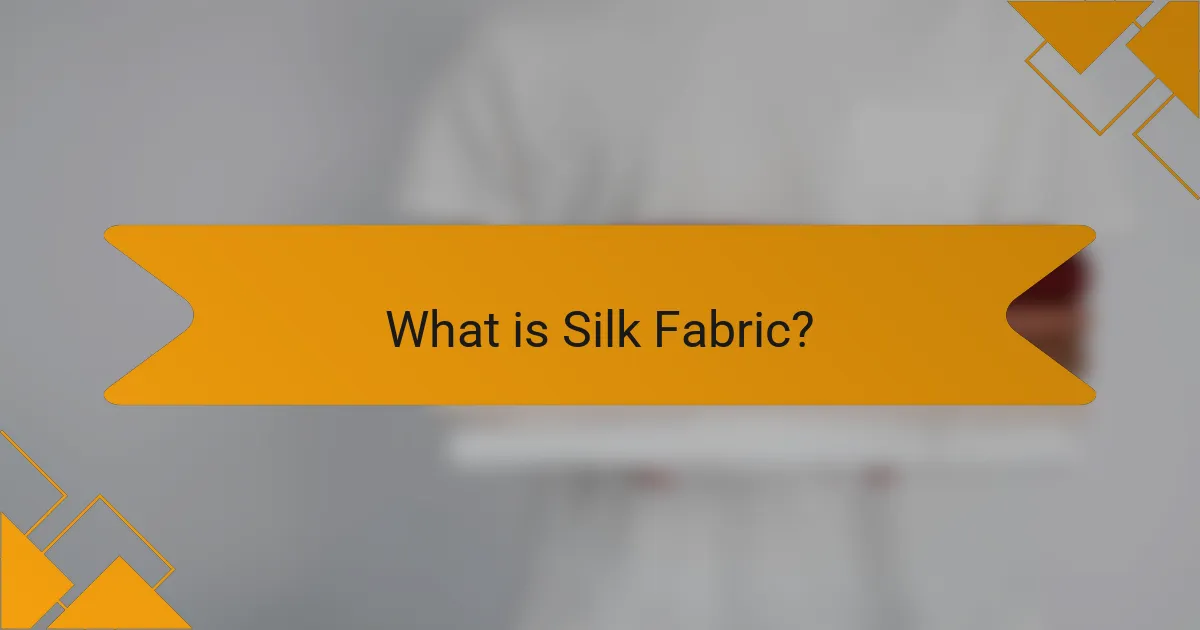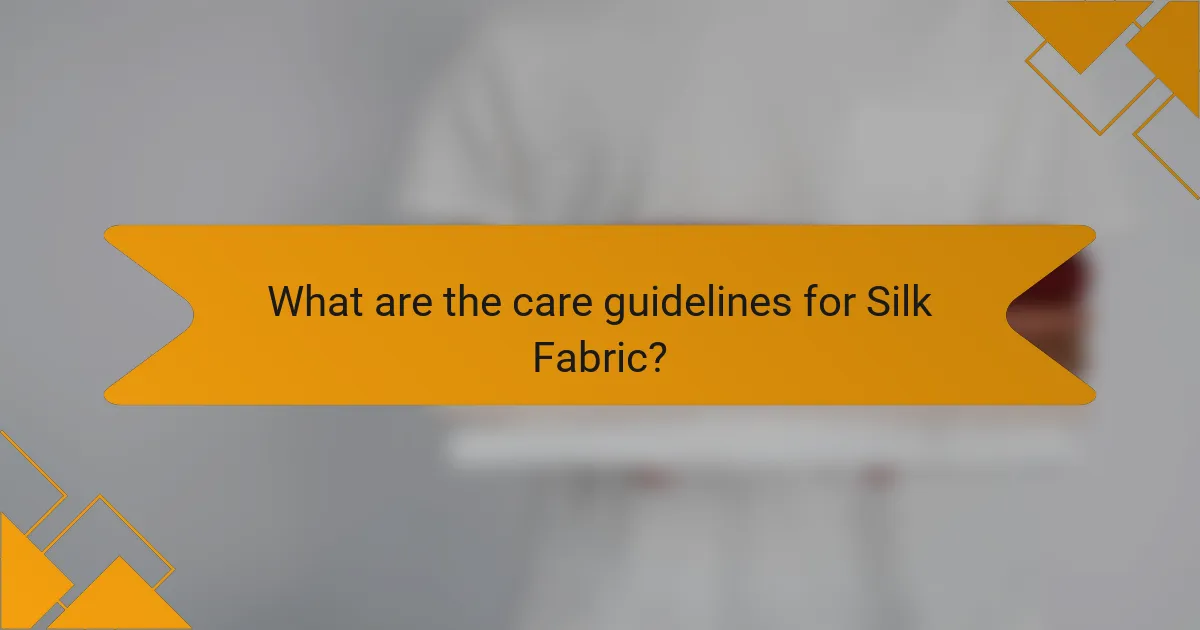Silk fabric is a natural fiber derived from the cocoons of the Bombyx mori silkworm, renowned for its softness, sheen, and luxurious feel. This fabric has a rich history, originating in ancient China, and is highly valued for its strength, durability, and breathability, as well as its temperature-regulating properties. Proper care is essential to maintain the quality and appearance of silk, including gentle washing techniques and appropriate storage methods. The article will cover the uses of silk in high-end clothing and textiles, as well as comprehensive care guidelines to ensure the longevity of this luxurious material.

What is Silk Fabric?
Silk fabric is a natural fiber produced by silkworms. It is known for its softness, sheen, and luxurious feel. The primary source of silk is the cocoons of the Bombyx mori silkworm. This fabric has been used for thousands of years, dating back to ancient China. Silk is highly valued for its strength and durability. It is also breathable and has a natural temperature-regulating ability. The unique protein structure of silk gives it a distinctive luster. Additionally, silk fabric is often used in high-end clothing, accessories, and home textiles.
How is Silk Fabric produced?
Silk fabric is produced through a process that involves harvesting silk from silkworms. The primary source of silk is the cocoons spun by the larvae of the silkworm, specifically the Bombyx mori species. Once the silkworms complete their lifecycle and form cocoons, these are collected and boiled to kill the pupae. This step makes it easier to unravel the long silk threads. The threads are then carefully unwound and spun into silk yarn. After spinning, the yarn is dyed and woven into fabric. The entire process reflects traditional methods that have been used for thousands of years, particularly in countries like China and India, where silk production dates back to around 2700 BC.
What are the different types of silk used in fabric production?
The different types of silk used in fabric production include mulberry silk, tussah silk, and eri silk. Mulberry silk is the most common type, produced by silkworms that feed exclusively on mulberry leaves. This silk is known for its smooth texture and high luster. Tussah silk comes from wild silkworms and has a coarser texture with a natural golden color. Eri silk is produced by domesticated silkworms that feed on castor leaves, offering a unique, soft feel and a matte finish. Each type of silk has distinct characteristics that make it suitable for various fabric applications.
What processes are involved in transforming silk fibers into fabric?
Silk fibers are transformed into fabric through several key processes. The first step is harvesting the silk cocoons from silkworms. After harvesting, the cocoons are boiled to kill the pupae and soften the sericin, a natural gum. This process allows the silk filaments to be unwound. The next step involves reeling the silk threads from the cocoons. The threads are then twisted together to create a stronger yarn.
Following this, the yarn is dyed using various methods to achieve the desired color. After dyeing, the silk yarn is woven or knitted into fabric. Weaving involves interlacing the threads on a loom, while knitting uses needles to create loops. Finally, the finished silk fabric undergoes finishing processes, which may include washing, ironing, and applying treatments for softness or sheen. These processes collectively yield the luxurious silk fabric known for its smooth texture and luster.
Why is Silk Fabric considered luxurious?
Silk fabric is considered luxurious due to its smooth texture and natural sheen. The fibers are produced by silkworms, making the material rare and unique. Silk has a natural ability to drape elegantly, enhancing its appeal in high-end fashion. Additionally, silk is known for its breathability and temperature-regulating properties. This makes it comfortable to wear in various climates. The production process is labor-intensive, contributing to its high cost. Historically, silk has been associated with royalty and wealth, further solidifying its luxurious reputation. The combination of these attributes makes silk fabric a symbol of luxury.
What are the sensory characteristics of silk that contribute to its luxury feel?
Silk is known for its luxurious feel due to several sensory characteristics. Its smooth texture glides effortlessly against the skin. This smoothness is a result of the fine fibers that compose silk. The fabric has a natural sheen that reflects light beautifully. This luster enhances the perception of luxury. Silk also has a lightweight quality, making it comfortable to wear. Additionally, silk possesses a unique drape, allowing it to flow elegantly. The fabric is breathable, providing comfort in various temperatures. These sensory attributes collectively contribute to the overall luxurious experience of wearing silk.
How does the history of silk influence its perception as a luxury material?
The history of silk significantly influences its perception as a luxury material. Originating in ancient China around 2700 BC, silk was a closely guarded secret. Its production involved intricate processes, making it rare and valuable. Silk became synonymous with wealth and status, often used by royalty and the elite. The Silk Road facilitated trade, spreading its allure across cultures. This historical exclusivity established silk as a symbol of luxury. Today, silk’s luxurious reputation persists due to its smooth texture and sheen. Its historical context reinforces its desirability in fashion and decor.
What are the common uses of Silk Fabric?
Silk fabric is commonly used for clothing, home decor, and accessories. In clothing, it is favored for its luxurious feel and drape. Popular garments made from silk include dresses, blouses, and ties. In home decor, silk is often used for curtains, upholstery, and bedding. Accessories such as scarves, handkerchiefs, and ties also frequently feature silk. The fabric’s softness and sheen enhance its appeal in these applications. Silk’s natural temperature-regulating properties make it comfortable to wear in various climates. Additionally, silk is valued for its hypoallergenic qualities, making it suitable for sensitive skin.
In which fashion items is silk predominantly used?
Silk is predominantly used in various fashion items including dresses, blouses, scarves, ties, and lingerie. Silk dresses are known for their luxurious feel and drape. Blouses made from silk offer elegance and comfort. Silk scarves add a touch of sophistication to any outfit. Ties crafted from silk are a staple in formal wear. Lingerie made from silk is favored for its softness and sensuality. These items highlight silk’s unique properties, such as its sheen and breathability.
How is silk utilized in home decor and furnishings?
Silk is utilized in home decor and furnishings primarily for its luxurious appearance and soft texture. It is commonly used in curtains, providing an elegant drape and light filtration. Silk upholstery adds sophistication to furniture, enhancing aesthetic appeal. Decorative pillows made from silk offer a touch of luxury and comfort to seating areas. Silk bed linens are favored for their smooth feel and temperature-regulating properties. Additionally, silk wall hangings serve as artistic focal points in rooms. The natural sheen of silk contributes to a refined ambiance in various settings. These uses highlight silk’s versatility in enhancing interior design.

What are the care guidelines for Silk Fabric?
Silk fabric requires gentle care to maintain its luxurious feel. Hand washing is recommended in cool water with mild detergent. Avoid wringing or twisting the fabric, as this can damage its fibers. Instead, gently press the water out and lay the silk flat to dry. If using a washing machine, select a delicate cycle and place silk items in a mesh bag. Iron silk on a low heat setting while it’s slightly damp to prevent burns. Always check the care label for specific instructions. These guidelines help preserve the quality and appearance of silk fabric.
How should Silk Fabric be washed and dried?
Silk fabric should be washed by hand in cold water using a gentle detergent. Avoid using hot water as it can damage the fibers. If machine washing is necessary, use a delicate cycle and place the silk items in a mesh laundry bag. After washing, do not wring or twist the fabric; instead, gently press out excess water. To dry silk, lay it flat on a clean towel or hang it to air dry away from direct sunlight. Avoid using a dryer, as heat can cause shrinkage and damage. These methods help maintain the integrity and appearance of silk fabric.
What specific washing methods are recommended for silk garments?
Hand washing is the recommended method for cleaning silk garments. Use cold water and a mild detergent specifically designed for silk. Gently agitate the water to create suds. Immerse the silk item and swirl it softly for a few minutes. Rinse thoroughly with cold water until all detergent is removed. Avoid wringing or twisting the fabric to prevent damage. If machine washing is necessary, use a delicate cycle in a mesh laundry bag. Always check the care label for specific instructions. These methods help maintain the silk’s texture and color.
How can you safely dry silk without damaging it?
To safely dry silk without damaging it, gently roll the fabric in a clean, dry towel to absorb excess moisture. Avoid wringing or twisting the silk, as this can distort its shape. Lay the silk flat on a dry towel in a shaded area to air dry. Direct sunlight can fade the color and weaken the fibers. Ensure proper airflow around the fabric to facilitate drying. Silk should never be placed in a dryer, as high heat can cause shrinkage and damage. Following these steps preserves the integrity and appearance of the silk.
What are the best practices for storing Silk Fabric?
Store silk fabric in a cool, dry place away from direct sunlight. Use breathable fabric bags or cotton sheets for storage. Avoid plastic containers as they can trap moisture. Ensure silk is clean and dry before storing to prevent mildew. Fold silk gently to avoid creasing. Do not hang silk, as it may stretch. Regularly check stored silk for any signs of damage or pests. These practices help maintain the quality and longevity of silk fabric.
How should silk items be folded or hung to prevent damage?
Silk items should be folded gently or hung on padded hangers to prevent damage. When folding silk, lay it flat on a clean surface. Smooth out wrinkles carefully to avoid creasing. Fold the item in half lengthwise, then in thirds. This minimizes stress on the fabric. When hanging, use padded hangers to support the weight. Avoid using metal hangers, as they can cause indentations. Silk should not be crammed into a tight space. Allow for airflow to prevent moisture buildup. Proper storage helps maintain the fabric’s luxurious feel and appearance.
What environmental conditions are ideal for silk storage?
Silk storage requires specific environmental conditions to maintain its quality. Ideal conditions include a cool, dry environment with temperatures between 60°F to 75°F. Humidity levels should be kept low, ideally around 40% to 50%. Exposure to direct sunlight must be avoided to prevent fading and degradation. Silk should also be stored in breathable fabric bags or boxes, not plastic, to allow air circulation. These conditions help prevent mold and mildew growth, preserving the integrity of the silk fibers. Proper storage ensures the longevity and luxurious feel of silk fabric.
What should you avoid when caring for Silk Fabric?
Avoid exposing silk fabric to direct sunlight. Prolonged sunlight can fade its colors and weaken the fibers. Do not wash silk in hot water. Hot water can cause shrinkage and damage the fabric’s texture. Avoid using bleach or harsh detergents. These chemicals can degrade silk and alter its appearance. Do not wring or twist silk when drying. This can distort its shape and lead to creasing. Avoid storing silk in damp places. Humidity can promote mildew and damage the fabric. Lastly, do not iron silk on high heat. High temperatures can scorch and ruin the delicate fibers.
What common mistakes can lead to damage of silk items?
Common mistakes that can lead to damage of silk items include improper washing, exposure to sunlight, and using harsh chemicals. Washing silk in hot water can cause shrinkage and color fading. Using a washing machine can lead to stretching and damage to the fabric. Sunlight exposure can result in fading and weakening of the fibers. Applying bleach or strong detergents can deteriorate the silk’s quality. Additionally, storing silk items in damp conditions can promote mold growth. These practices can significantly reduce the lifespan of silk products.
How can certain chemicals affect the integrity of silk fabric?
Certain chemicals can significantly compromise the integrity of silk fabric. For instance, strong acids can weaken silk fibers, leading to damage and degradation. Alkaline substances can also alter the fabric’s structure, causing discoloration and brittleness. Detergents containing harsh chemicals may strip silk of its natural proteins, resulting in loss of sheen and softness. Exposure to chlorine bleach can cause irreversible damage, including holes and fraying. The presence of certain solvents can lead to discoloration and weakening of the fibers. Proper care and the use of gentle cleaning agents are essential to maintain silk’s integrity. Studies have shown that silk’s tensile strength can be reduced by up to 50% when exposed to aggressive chemicals.

How can you maximize the benefits of Silk Fabric?
To maximize the benefits of silk fabric, ensure proper care and maintenance. Regularly clean silk items with a gentle detergent to preserve their luster. Avoid exposure to direct sunlight, as it can fade the color. Store silk in a cool, dry place to prevent damage from moisture. Use padded hangers for garments to maintain their shape. Iron silk on a low setting, using a cloth to protect the fabric. These practices help maintain the quality and longevity of silk, ensuring it retains its luxurious feel and appearance over time.
What styling tips can enhance the appearance of Silk Fabric?
To enhance the appearance of silk fabric, choose complementary colors that highlight its luster. Opt for tailored silhouettes to maintain the fabric’s elegant drape. Layer silk with lightweight materials to create texture without overwhelming the fabric. Accessorize with understated jewelry to keep the focus on the silk. Utilize proper care techniques, such as gentle washing and air drying, to preserve its sheen. Avoid heavy embellishments that can detract from silk’s natural beauty. Lastly, consider the occasion; silk shines in both casual and formal settings, enhancing its versatility.
How can you accessorize silk outfits for different occasions?
Accessorizing silk outfits varies by occasion. For formal events, elegant jewelry like pearl earrings enhances the outfit’s luxury. A classic clutch bag complements the silk’s texture. For casual outings, a denim jacket adds a relaxed vibe. Statement sunglasses can elevate the look effortlessly. During summer, lightweight scarves can provide both style and practicality. In colder months, a tailored blazer can add sophistication. Footwear choices like heels or stylish flats depend on the formality. Accessories should harmonize with the silk’s sheen and drape to maintain elegance.
What layering techniques work best with silk garments?
Silk garments layer best with lightweight fabrics, such as chiffon or cotton. These materials provide comfort without overwhelming the delicate nature of silk. Pairing silk with structured pieces like tailored blazers adds sophistication. This combination maintains the elegance of silk while adding formality. Additionally, wearing silk under heavier fabrics like wool can create warmth. This technique allows for versatility in colder weather. Using silk as a base layer can enhance overall outfit fluidity. It keeps the look polished while providing a luxurious feel.
What troubleshooting tips are available for Silk Fabric maintenance?
To maintain silk fabric effectively, several troubleshooting tips can be applied. First, always test for colorfastness by wetting a small area before washing. If the color bleeds, dry clean the fabric instead. Second, use a mild detergent specifically designed for silk. Harsh chemicals can damage the fibers. Third, hand wash silk in cold water to prevent shrinking. Machine washing should be avoided unless the label indicates otherwise. Fourth, avoid wringing or twisting the fabric when removing water. Instead, gently press the water out. Fifth, air dry silk away from direct sunlight to prevent fading. Finally, store silk in a cool, dry place, ideally wrapped in acid-free tissue. These tips ensure the longevity and beauty of silk fabric.
How can you remove stains from silk without causing damage?
To remove stains from silk without causing damage, use a gentle approach. Start by blotting the stain with a clean, dry cloth. Avoid rubbing, as this can harm the fabric. Prepare a solution of lukewarm water and a few drops of mild detergent. Test this solution on a hidden area of the silk first. If safe, apply the solution to the stained area using a soft cloth. Blot gently and rinse with cool water. Do not wring or twist the silk. Instead, lay it flat on a clean towel to dry. This method preserves the integrity of the silk while effectively removing stains.
What steps can you take if silk items lose their luster?
To restore the luster of silk items, gently hand wash them in lukewarm water with a mild detergent. Avoid harsh chemicals that can damage the fibers. Rinse thoroughly to remove all soap residues. After rinsing, do not wring the silk. Instead, lay the item flat on a clean, dry towel to absorb excess water. Allow it to air dry away from direct sunlight and heat sources. Once dry, you can lightly steam the silk to revive its sheen. Regular care and proper washing techniques help maintain the silk’s natural luster.
Silk fabric is a natural fiber renowned for its luxurious feel, softness, and sheen, primarily produced from the cocoons of the Bombyx mori silkworm. This article provides an overview of silk fabric, including its production processes, various types, and historical significance that contribute to its luxury status. Additionally, it outlines care guidelines for maintaining silk’s appearance and longevity, common uses in fashion and home decor, and best practices for storage and stain removal. Key sensory characteristics and styling tips for enhancing silk garments are also discussed, emphasizing the fabric’s versatility and enduring appeal.


